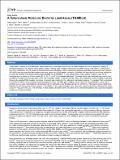Files in this item
A tuberculosis molecular bacterial load assay (TB-MBLA)
Item metadata
| dc.contributor.author | Sabiiti, Wilber | |
| dc.contributor.author | Mtafya, Bariki Anyamkisye | |
| dc.contributor.author | Alferes De Lima, Daniela | |
| dc.contributor.author | Dombay, Evelin | |
| dc.contributor.author | Baron, Vincent Olivier | |
| dc.contributor.author | Azam, Khalide | |
| dc.contributor.author | Orascova, Katarina | |
| dc.contributor.author | Sloan, Derek James | |
| dc.contributor.author | Gillespie, Stephen Henry | |
| dc.date.accessioned | 2020-05-05T11:30:02Z | |
| dc.date.available | 2020-05-05T11:30:02Z | |
| dc.date.issued | 2020-04-30 | |
| dc.identifier | 261093330 | |
| dc.identifier | 11feb7a0-de70-4c87-a62a-6204f5241064 | |
| dc.identifier | 85084786598 | |
| dc.identifier | 000530896100012 | |
| dc.identifier.citation | Sabiiti , W , Mtafya , B A , Alferes De Lima , D , Dombay , E , Baron , V O , Azam , K , Orascova , K , Sloan , D J & Gillespie , S H 2020 , ' A tuberculosis molecular bacterial load assay (TB-MBLA) ' , Journal of Visualized Experiments , vol. 158 , e60460 . https://doi.org/10.3791/60460 | en |
| dc.identifier.issn | 1940-087X | |
| dc.identifier.other | ORCID: /0000-0001-6537-7712/work/73701289 | |
| dc.identifier.other | ORCID: /0000-0002-4742-2791/work/73702088 | |
| dc.identifier.other | ORCID: /0000-0002-5125-1657/work/75997035 | |
| dc.identifier.other | ORCID: /0000-0002-7888-5449/work/73701804 | |
| dc.identifier.uri | https://hdl.handle.net/10023/19879 | |
| dc.description | Funding: European and Developing Countries Clinical Trials Partnership (EDCTP) – Pan African Biomarker Expansion program (PanBIOME) grant SP.2011.41304.008. Support was also obtained the University of St Andrews School of Medicine research grant. | en |
| dc.description.abstract | Tuberculosis is caused by Mycobacterium tuberculosis (Mtb), a pathogen classified by the United Nations (UN) as a dangerous category B biological substance. For the sake of the workers’ safety, handling of all samples presumed to carry Mtb must be conducted in a containment level (CL) 3 laboratory. The TB molecular bacterial load assay (TB-MBLA) test is a reverse transcriptase quantitative polymerase chain reaction (RT-qPCR) test that quantifies Mtb bacillary load using primers and dual-labelled probes for 16S rRNA. We describe the use of heat inactivation to render TB samples noninfectious while preserving RNA for the TB-MBLA. A 1 mL aliquot of the sputum sample in tightly closed 15 mL centrifuge tubes is boiled for 20 min at either 80 °C, 85 °C, or 95 °C to inactivate Mtb bacilli. Cultivation of the heat inactivated and control (live) samples for 42 days confirmed the death of TB. The inactivated sample is then spiked with 100 µL of the extraction control and RNA is extracted following the standard RNA isolation procedure. No growth was observed in the cultures of heat treated samples. The isolated RNA is subjected to real-time RT-qPCR, which amplifies a specific target in the Mtb 16S rRNA gene, yielding results in the form of quantification cycles (Cq). A standard curve is used to translate Cq into bacterial load, or estimated colony forming units per mL (eCFU/mL). There is an inverse relationship between Cq and the bacterial load of a sample. The limitation is that heat inactivation lyses some cells, exposing the RNA to RNases that cause a loss of <1 log10eCFU/mL (i.e., <10 CFU/mL). Further studies will determine the proportion of very low burden patients that cause false negative results due to heat inactivation. | |
| dc.format.extent | 10 | |
| dc.format.extent | 922272 | |
| dc.language.iso | eng | |
| dc.relation.ispartof | Journal of Visualized Experiments | en |
| dc.subject | QR Microbiology | en |
| dc.subject | DAS | en |
| dc.subject | SDG 3 - Good Health and Well-being | en |
| dc.subject.lcc | QR | en |
| dc.title | A tuberculosis molecular bacterial load assay (TB-MBLA) | en |
| dc.type | Journal article | en |
| dc.contributor.institution | University of St Andrews. Infection and Global Health Division | en |
| dc.contributor.institution | University of St Andrews. School of Medicine | en |
| dc.contributor.institution | University of St Andrews. Sir James Mackenzie Institute for Early Diagnosis | en |
| dc.contributor.institution | University of St Andrews. Centre for Biophotonics | en |
| dc.contributor.institution | University of St Andrews. Global Health Implementation Group | en |
| dc.contributor.institution | University of St Andrews. Gillespie Group | en |
| dc.contributor.institution | University of St Andrews. Infection Group | en |
| dc.contributor.institution | University of St Andrews. Biomedical Sciences Research Complex | en |
| dc.identifier.doi | 10.3791/60460 | |
| dc.description.status | Peer reviewed | en |
This item appears in the following Collection(s)
Items in the St Andrews Research Repository are protected by copyright, with all rights reserved, unless otherwise indicated.

